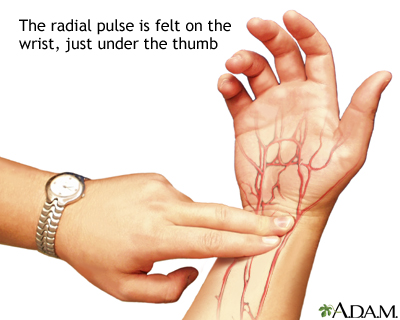Health Library
Pulse
Heart rate; Heart beat
The pulse is the number of heartbeats per minute.
Images




I Would Like to Learn About:
How the Test is Performed
The pulse can be measured at areas where an artery passes close to the skin. These areas include the:
- Back of the knees
- Groin
- Neck
- Temple
- Top or inner side of the foot
- Wrist
To measure the pulse at your wrist, place your index and middle finger over the underside of your opposite wrist, below the base of the thumb. Press with flat fingers until you feel the pulse.
To measure the pulse on the neck, place the index and middle fingers just to the side of the Adam's apple, in the soft, hollow area. Press gently until you locate the pulse.
Note: Sit or lie down before taking the neck pulse. The neck arteries in some people are sensitive to pressure. Fainting or slowing of the heartbeat can result. Also, do not take the pulses on both sides of the neck at the same time. Doing so can slow the flow of blood to the head and lead to fainting.
Once you find the pulse, count the beats for 1 full minute. Or, count the beats for 30 seconds and multiply by 2. This will give the beats per minute.
How to Prepare for the Test
To determine the resting heart rate, you must have been resting for at least 10 minutes. Take the exercise heart rate while you are exercising.
How the Test will Feel
There is a slight pressure from the fingers.
Why the Test is Performed
Measuring the pulse gives important information about your health. Any change from your normal heart rate can indicate a health problem. Fast pulse may signal an infection or dehydration. In emergency situations, the pulse rate can help determine if the person's heart is pumping.
Pulse measurement has other uses as well. During or immediately after exercise, the pulse rate gives information about your fitness level and health.
Normal Results
For resting heart rate:
- Newborns 0 to 1 month old: 70 to 190 beats per minute
- Infants 1 to 11 months old: 80 to 160 beats per minute
- Children 1 to 2 years old: 80 to 130 beats per minute
- Children 3 to 4 years old: 80 to 120 beats per minute
- Children 5 to 6 years old: 75 to 115 beats per minute
- Children 7 to 9 years old: 70 to 110 beats per minute
- Children 10 years and older, and adults (including seniors): 60 to 100 beats per minute
- Well-trained athletes: 40 to 60 beats per minute
What Abnormal Results Mean
Resting heart rates that are continually high (tachycardia) may mean a problem. Talk to your health care provider about this. Also discuss resting heart rates that are below the normal values (bradycardia).
A pulse that is very firm (bounding pulse) and that lasts for more than a few minutes should be checked by your provider as well. An irregular pulse can also indicate a problem.
A pulse that is hard to locate may mean blockages in the artery. These blockages are common in people with diabetes or hardening of the artery from high cholesterol. Your provider may order a test known as a Doppler study to check the blockages.
Related Information
Pulse - boundingHeart palpitations
References
Bernstein D. History and physical examination in cardiac evaluation. In: Kliegman RM, St Geme JW, Blum NJ, Shah SS, Tasker RC, Wilson KM, eds. Nelson Textbook of Pediatrics. 21st ed. Philadelphia, PA: Elsevier; 2020:chap 449.
Schriger DL. Approach to the patient with abnormal vital signs. In: Goldman L, Schafer AI, eds. Goldman-Cecil Medicine. 26th ed. Philadelphia, PA: Elsevier; 2020:chap 7.
BACK TO TOPReview Date: 1/16/2021
Reviewed By: Linda J. Vorvick, MD, Clinical Associate Professor, Department of Family Medicine, UW Medicine, School of Medicine, University of Washington, Seattle, WA. Also reviewed by David Zieve, MD, MHA, Medical Director, Brenda Conaway, Editorial Director, and the A.D.A.M. Editorial team. Editorial update 09/30/2021.
 | A.D.A.M., Inc. is accredited by URAC, for Health Content Provider (www.urac.org). URAC's accreditation program is an independent audit to verify that A.D.A.M. follows rigorous standards of quality and accountability. A.D.A.M. is among the first to achieve this important distinction for online health information and services. Learn more about A.D.A.M.'s editorial policy, editorial process and privacy policy. A.D.A.M. is also a founding member of Hi-Ethics. This site complies with the HONcode standard for trustworthy health information: verify here. |
The information provided herein should not be used during any medical emergency or for the diagnosis or treatment of any medical condition. A licensed medical professional should be consulted for diagnosis and treatment of any and all medical conditions. Links to other sites are provided for information only -- they do not constitute endorsements of those other sites. © 1997- 2023 A.D.A.M., a business unit of Ebix, Inc. Any duplication or distribution of the information contained herein is strictly prohibited.
